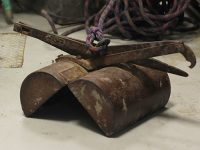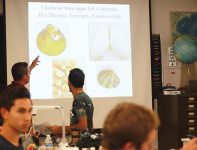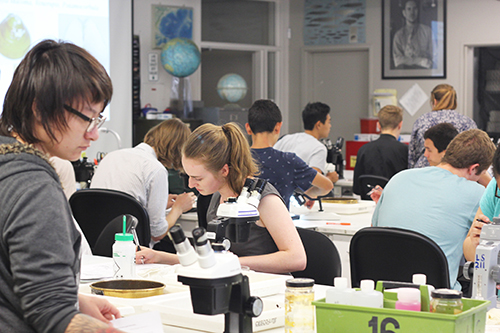 DOWNLOAD the September 2016 Issue PDF
DOWNLOAD the September 2016 Issue PDF
Guest Columnist: Marilyn Browning Vogel, Professor, Diablo Valley College

The Ocean 102 lab at Diablo Valley College in Pleasant Hill is a proper marine biological laboratory. It smells faintly of seaweed and formaldehyde, while fearsome, plastic versions of marine predators (sharks that happen to squeak) hang from the ceiling. A somewhat functional soldering iron sits on the counter in the supply room next to an open box of Girl Scout cookies. The Peterson benthic grab, a heavy jaw-like affair attached to a long rope sits in the supply room. Pity the TA who has forgotten to rinse it off since its last use at the various shoreline localities where Ocean 102 lab sections collect samples. As its name suggests, the Peterson benthic grab grabs the benthic, the benthic being the mud, rock and organisms that make up the bay floor. The benthic grab collects a known surface area of the sediment and allows oceanography students (or the marine scientists they hope to become) to tally the type and number of organisms found in that particular patch. After rinsing off the mud, Ocean 102 students will pluck out various species of worms, shrimp and clams that live on the bottom of the Bay, and mark them down on official laboratory tally sheets.
Nearly every semester, after sampling bay mud from Berkeley to Pittsburg, Ocean 102 students discover an astonishing surfeit of a tiny clam known as Potamocorbula Amurensis. One of the clam’s shells tends to be larger than the other, making it easy to identify according to its informal name, the ‘overbite clam’. Back in the lab, students will spend many hours assembling little piles of Potamocorbula shells, and learning the lessons it has to teach about how estuarine ecosystems work.
 Dr. John Freytag is a professor of biology and director of the Diablo Valley College oceanography program. Dressed in flip-flops and a faded blue shirt, he is a proper marine biologist, on whom falls the task of turning Potamocorbula into a teachable moment. “With the sampling we do, it’s an interesting opportunity to look at snapshots of what’s happening in the Bay throughout the year, and we see fluctuations. There will be times particularly in the spring where we see a lot of dead or empty shells. If huge amounts of fresh water were allowed to flow through the Bay, it would effectively push Potamocorbula further west.”
Dr. John Freytag is a professor of biology and director of the Diablo Valley College oceanography program. Dressed in flip-flops and a faded blue shirt, he is a proper marine biologist, on whom falls the task of turning Potamocorbula into a teachable moment. “With the sampling we do, it’s an interesting opportunity to look at snapshots of what’s happening in the Bay throughout the year, and we see fluctuations. There will be times particularly in the spring where we see a lot of dead or empty shells. If huge amounts of fresh water were allowed to flow through the Bay, it would effectively push Potamocorbula further west.”
Potamcorbula’s remarkable abundance is also a teachable moment about invasive species and community science. The clam arrived in the Bay sometime around 1986 as floating larvae in the ballast water of cargo ships arriving from Asia. (Potamocorbula is also referred to as the ‘Asian clam’.) The organism can tolerate a wide range of salinities and makes strident incursions deep into the Bay Delta, especially during times of drought, when freshwater outflows are absent.
“Some of the species that arrive in ballast water prove to be devastating,” Freytag explains to his students. “The estuary here is considered to be the most highly invaded estuary in the world, which is not a title you want to hold.”
Like many sessile, benthic organisms, Potamocorbula is a filter feeder, meaning that it sucks in water and harvests plankton caught in the intake. Due to its abundance, scientists estimate that Potamocorbula can currently filter feed on a volume of water equal the entire volume Suisun Bay, in one day. As it vacuums up the plankton that form the base of the food web, the clam has decimated native fish populations and changed some of the most basic characteristics of the bay ecosystem, ranging from the structure of the food web to the color and clarity of the water.
While its name is a mouthful, Potamocorbula is unfortunately inedible, even for many non-human consumers. Sturgeon feed on the clam but scientists have found that it can pass straight through the sturgeon digestive track, alive and well, landing wherever the tides or alimentary elimination will carry it. The clam does serve as a food source for ducks and even the native dungeness crab, which use the lip of the clam’s overbite to pry it apart.
The clam itself can eat a wider range of planktonic organisms than scientists had previously believed possible. In addition filtering microscopic algae out of the water column, Potoamocorbula also feeds on bacteria and tiny crustaceans known as copepods. A study in 1991 found that Potamocorbula had reduced populations of the three most common types of copepods by as much as 53-91%, and could consume as much at 8% of the juvenile population per day. It’s nothing personal, Potamocorbula also eats its own larvae, but not in quantities sufficient to overcome its ability to lay 45,000 – 220,000 eggs during a given breeding season, or as in the case of a drought, continuously throughout the year.

As Ocean 102 students tally their shells and learn about plankton, food webs and invasives, they seldom appreciate the historical role their laboratory course has played in the Potamocorbula saga. Dr. Bill Stevenson founded the Diablo Valley College Oceanography program and orchestrated its first training cruises in 1974. Later joined by his partner Dianna Matthias, Stevenson oversaw the lab sections and students that discovered some of the first Potamocorbula specimens ever observed in the San Francisco Bay. I spoke with them recently at their home in Martinez. “This was in 1986,” he told me. “It was three clams that the kids found that they couldn’t identify. It looked like a clam that had an overbite. One shell is bigger than the other. So I put some students on it, said ‘why don’t you kids research this?”
In the case of this particular invasion, the clam itself may have traveled faster through the Bay Delta ecosystem than news of its arrival. It wasn’t until two years later in 1988 that Stevenson and his students got word that that the U.S. Geological Survey (USGS) had identified a clam with an overbite that was taking over. After a few phone calls Stevenson realized that the DVC training cruise samples may have contained some of the first documented occurrences of the organism. “We went back through samples and found lots of them,” he says. Three Potamocorbula in the Suisun Bay benthic grab samples collected by DVC Oceanography students in October 1986 became the earliest documented occurrence of the organism at that locality. Ocean 102 data helped the USGS pinpoint Potamocorbula’s arrival and understand its immediate and devastating expansion.
As with many ecological threats to the Bay Delta, Potamocorbula’s invasion resulted from a Gordian knot of economic, environmental and logistical factors. From 1987 to 1992, California experienced its most severe drought since the 1930s. The year before the drought began had been a record year for rain. The San Francisco Estuary swelled with spring floods so powerful that they ripped out the existing benthic communities of the inner estuary and carried them out to sea. This was a one-two punch for the Bay. The floor of the upper estuary was a blank slate of benthic habitat, free for the taking.
One thing that keeps Potamocorbula in check is fresh water, which would have been in extremely short supply for the five years following the 1986 floods. With no freshwater flushing, Potamocorbula spread deep into the upper estuary. “The numbers early in the invasion were pretty surprising but we had no idea Potamocorbula would persist and become a member of the North Bay community,” wrote Dr. Jan Thompson in an email to me on the topic.
Thompson is a hydrodynamic engineer at the USGS in Menlo Park. She also has a degree in ecology and has studied Potamocorbula since its 1986 debut. “Essentially all of the bivalves in the Bay are exotics and they move around as salinity changes. Most of these bivalves are reasonably good at osmo-regulating, but none of them come close to Potamocorbula. There were no persistent populations of bivalves in the North Bay until it arrived.” This is to say that the natural variability of salinity in the Bay and Delta keeps the ecosystem in flux, theoretically fostering a much higher level of diversity. Static conditions, on the other hand, can favor takeover by a single organism.
Similar to a military campaign, once the line of defense was broken, the invaders poured in and took over. “It was amazing when I started going out in 1991,” Dianna Matthias told me. She had just begun teaching Ocean 102 and taking students on research cruises at the height of the 1987-92 drought. “Sometimes we’d bring up a bottom grab and think it was sand…. Each little grain was a tiny, tiny little clam. I mean, it was in the millions or billions even! At that time, I started figuring there was something going on and it didn’t look good.”
 Limnologists sometimes describe clams, bivalves and other mollusks as ‘ecosystem engineers.’ Mollusks are called thus because they filter the water column, help link up the aquatic food web, and contribute shell material to benthic habitat. In ecosystems like the Chesapeake Bay, the loss of oyster beds has left the water column a murky, anoxic soup riddled with too many jellyfish. Potamocorbula’s re-engineering of the San Francisco estuary has created the opposite problem. The millions of invasive filter feeders now make the water too clear and the vast blooms of plankton that once nourished many species now mostly nourish just one: the overbite clam. The precipitous decline in native fish populations, especially in the early 2000s, was due to myriad factors, but Potomocorbula certainly contributed to the crash.
Limnologists sometimes describe clams, bivalves and other mollusks as ‘ecosystem engineers.’ Mollusks are called thus because they filter the water column, help link up the aquatic food web, and contribute shell material to benthic habitat. In ecosystems like the Chesapeake Bay, the loss of oyster beds has left the water column a murky, anoxic soup riddled with too many jellyfish. Potamocorbula’s re-engineering of the San Francisco estuary has created the opposite problem. The millions of invasive filter feeders now make the water too clear and the vast blooms of plankton that once nourished many species now mostly nourish just one: the overbite clam. The precipitous decline in native fish populations, especially in the early 2000s, was due to myriad factors, but Potomocorbula certainly contributed to the crash.
Thirty years later, Ocean 102 is still keeping an eye on Potamocorbula, along with the US Geological Survey and other agencies. Increased awareness of Potamocorbula’s effects helps policy makers protect habitat and endangered species like the Delta smelt. Environmental groups have begun calling for protection plans that manage Potamocorbula and other bivalves that threaten the smelt’s food supply. New Zealand, a nation known for its innovative approaches to protecting native species, got out in front by issuing a management plan for Potamocorbula back in 2001. Perhaps the most hopeful aspect of the Potamocorbula’s invasion is how little we know about the organism. The US Geological Survey’s Jan Thompson points out that while mechanisms for long distance transport of the bivalve are in place, Potamocorbula doesn’t seem to have taken to other west coast estuaries. These estuaries enjoy greater volumes and more natural cycles of freshwater flow compared to the San Francisco Estuary.
John Freytag is also optimistic, but as a teacher that’s kind of his job. This September, Ocean 102 surveys found a handful of Potamocorbula juveniles in their sediment samples but only a few full grown shells. Certain surveys over the last few semesters have similarly yielded only limited evidence of mature individuals. Whatever the next chapter, Ocean 102 will grab on to it.